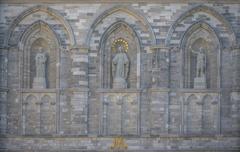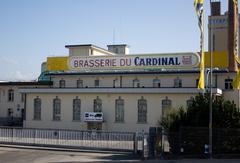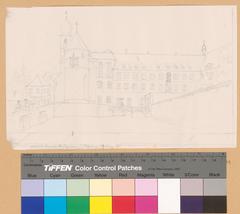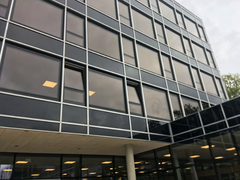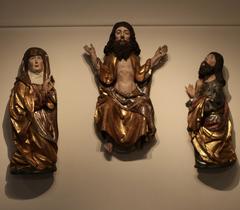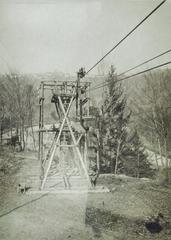Visiting Pont de Berne / Bernbrücke in Fribourg: Hours, Tickets, and Tips
Date: 20/07/2024
Introduction
The Pont de Berne, also known as the Bernbrücke, is a historic wooden bridge located in Fribourg, Switzerland. Constructed around 1250, this bridge serves as a relic of medieval engineering and a vital link between the lower and upper towns of Fribourg. Its covered design, spanning approximately 40 meters across the Sarine River, showcases traditional building techniques and local timber that have stood the test of time. The bridge’s architectural ingenuity and historical significance have cemented its place in Swiss heritage, making it a must-visit for history enthusiasts and tourists alike. (Fribourg Tourism)
Table of Contents
- Origins and Construction
- Architectural Significance
- Historical Events and Renovations
- Cultural and Historical Importance
- Modern-Day Preservation Efforts
- Visitor Experience
- FAQ
Origins and Construction
The Pont de Berne, constructed around 1250, was built to facilitate the movement of people and goods across the Sarine River, which was a significant barrier to trade and communication in the region. The bridge’s original construction is a testament to medieval engineering, utilizing local timber and traditional building techniques.
Architectural Significance
The Pont de Berne is an exemplary model of medieval wooden bridge construction. It features a covered design to protect the wooden structure from the elements, thereby extending its lifespan. The bridge spans approximately 40 meters and is supported by a series of wooden piers and trusses. The roof is covered with wooden shingles, and the sides are enclosed with wooden planks, providing both structural integrity and protection from weather conditions.
Historical Events and Renovations
Throughout its long history, the Pont de Berne has witnessed numerous historical events and has undergone several renovations to preserve its structural integrity. One of the most significant renovations occurred in the 17th century when the bridge was extensively repaired and reinforced. In the 19th century, the bridge faced the threat of demolition due to the increasing demand for modern infrastructure. However, local authorities and preservationists successfully campaigned for its preservation. (Fribourg Tourism)
Cultural and Historical Importance
The Pont de Berne holds a special place in the cultural and historical landscape of Fribourg. It is not only a functional piece of infrastructure but also a symbol of the city’s medieval heritage. The bridge has been featured in numerous historical documents, paintings, and photographs. Its inclusion in the Swiss Inventory of Cultural Property of National and Regional Significance underscores its importance.
Modern-Day Preservation Efforts
In recent years, the Pont de Berne has been the focus of ongoing preservation efforts. These efforts include regular maintenance, structural assessments, and conservation projects aimed at preserving the bridge’s historical integrity. Modern technologies, such as 3D scanning and digital modeling, have been employed to monitor the bridge’s condition and plan future preservation activities. (Fribourg Tourism)
Visitor Experience
Visiting Hours and Ticket Prices
The Pont de Berne is open to visitors year-round. There is no entrance fee, and the bridge is accessible at any time of the day.
Guided Tours and Informational Plaques
Visitors can enhance their experience by joining guided tours that provide historical context and insights into the bridge’s construction and significance. Informational plaques along the bridge offer additional details for those exploring on their own.
Photography Tips
The Pont de Berne offers a picturesque setting for photography enthusiasts. Early morning or late afternoon light provides the best conditions for capturing the bridge’s intricate wooden construction and scenic surroundings.
Nearby Attractions
The surrounding area includes the Old Town of Fribourg, known for its well-preserved medieval architecture and charming streets. Other nearby attractions include the Cathedral of St. Nicholas and the Fribourg Art and History Museum.
Accessibility and Travel Tips
The bridge is accessible to pedestrians and offers a flat, even surface suitable for wheelchairs and strollers. Public transportation options are available nearby, making it easy to visit the bridge as part of a day trip to Fribourg.
FAQ
What are the visiting hours for Pont de Berne? The Pont de Berne is open to visitors 24/7.
How much does it cost to visit Pont de Berne? There is no entrance fee to visit the Pont de Berne.
Is Pont de Berne wheelchair accessible? Yes, the bridge is accessible to wheelchairs and strollers.
Conclusion
The Pont de Berne stands as a remarkable example of medieval engineering and a testament to the rich history of Fribourg. Its preservation and continued use as a pedestrian bridge highlight the importance of maintaining historical landmarks for future generations. As a symbol of the city’s heritage, the Pont de Berne remains an enduring and cherished part of Fribourg’s cultural landscape.
For more information on the Pont de Berne and its historical significance, you can visit the official Fribourg Tourism website. Additionally, consider downloading the Audiala mobile app for more travel tips and updates on Fribourg historical sites.
References
- Exploring Pont de Berne - History, Visiting Hours, and Travel Tips, 2024, Fribourg Tourism
- Exploring Pont de Berne - A Guide to Fribourg’s Historic Covered Bridge, 2024, Fribourg Tourism
